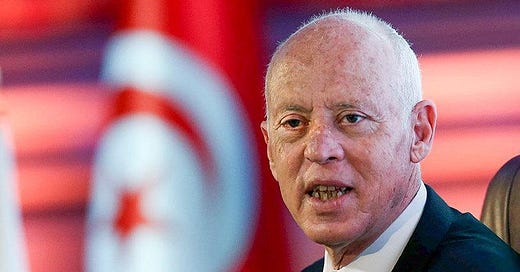The end of Tunisia's democratic path
What scholars have to say about Tuesday's constitutional referendum
Image: AFP/KARIM JAAFAR
Once upon a time, Tunisia was viewed as the success story of the Arab uprisings. An entire genre of political science analysis sought to explain why Tunisia had managed to successfully find a path towards a consolidated democratic transition where every other Arab country had failed. The most popular comparison was, of course, to Egypt, where a turbulent two year attempted democratic transition ended in a military coup and violent repression of Islamists (see my review of books by Mona el-Ghobashy and Jannis Grimm for discussion of that case).
But then President Kais Saeid moved to end all of that. Taking advantage of economic crisis, the effects of COVID, and a stalemated Parliament, Saied declared a state of emergency, suspended the constitution, dissolved the Parliament, purged the judiciary, and cracked down on dissent. He then announced an online debate on a new constitutional draft, and ultimately produced the depressingly autocratic document which will be put to a vote on July 25. Whether the divided opposition opts for a boycott or a no vote, it seems likely that Saied’s constitution will win the referendum, paving the way for a return to the authoritarian one man rule of the Ben Ali era.
One good place to start for the roots of Tunisia’s democratic crisis is with a symposium I edited last fall for the American Political Science Association’s MENA Politics section newsletter. Fourteen scholars contributed to the symposium, covering a wide range of topics. Holger Albrecht, Dina Bishara, Michael Bufano and Kevin Koehler took a close look at Tunisian public opinion survey research and found a steady growth in a willingness to accept one man rule over democracy and identified the popular base for Saied’s anti-systemic politics (for a fuller discussion of their findings and argument, see their article in Mediterranean Politics). Nate Grubman similarly emphasized that whatever Tunisians thought about democracy, survey evidence suggested that they did not think they currently lived in a democracy. John Entelis urged caution in making conclusions about where Saied’s gambit was heading, but observed evidence for each of the indicators offered by Levitsky and Ziblatt for “how democracies die.”
Tarek Kahlouni sought to decipher Saied’s political vision and the attraction of his populist stances. Bedirhan Mutlu and Salah Yasun similarly placed the rise of Saied’s populism in the failure of the post-transition political class. Giulia Cimini focused on the disconnect between procedural democracy and the politics of the economy which created a blind spot for many observers of Tunisia’s transition. Kirstie Lynn Dobbs examined the endemic frustration of Tunisia’s youth and their marginalization in the emergent democratic system. Rory McCarthy looked at where and how the Islamist Ennahda movement had gone wrong in its embrace of democratic participation. Mariam Salehi looked at the failures of the transitional justice process. And Lana Salman’s keenly observed essay looked at the lived experience of humiliation among Tunisia’s marginalized urban poor.
A few pieces I edited for the Washington Post’s Monkey Cage recently also offer useful context:
Sharan Grewal, Ian DeHaven, and Salah-Dean Satouri, “Will Tunisia’s opposition unite against the July 25 referendum?” The authors interviewed a range of opposition figures to find out their views on whether to boycott or to encourage a “no” vote. The results are not encouraging. Elsewhere, Mohamad Khallouli makes the case for why the opposition should boycott to deny the constitution legitimacy.
Zaid al-Ali, “Tunisia’s draft constitution solidifies one-man rule.” One of the leading scholars of Arab constitutions offers low marks for the constitutional draft. Nathan Brown, my GW colleague and another leading expert on Arab constitutions, offered his own take on Saied’s constitution here.
Michael Robbins, “Arab citizens know democracy isn’t perfect. They want it anyway.” A write-up of the new wave of the Arab Barometer survey, which finds some silver linings in the data (which can usefully be compared to the findings reported by Albrecht, Bishara, Bufano and Koehler above) but little hope for a Tunisian course correction.
Things I Didn’t Edit
There’s been a lot of other great stuff being written about Tunisia’s crisis. Here’s a few that caught my eye.
The Italian Institute for the Study of International Politics (ISPI) has a useful dossier on the referendum edited by Lorenzo Fruganti and Valeria Talbot. It includes essays by Youssef Cherif (‘less bread and less freedom’), Giulia Cimini (the trials of Ennahda), Daniel Brumberg (the West’s disinterest) and many more.
The Tahrir Institute for Middle East Policy (TIMEP) has usefully collected sharp analysis by a number of young Tunisian activists, including Aymen Basallah on the ‘illusion of democratic choice’ in Kais Saeid’s Tunisia, Ghazoua Ltaeif on the assault on the independence of the judiciary, and a useful explainer of the path to the referendum by Mai al-Sadany and Mondher Tounsi.
Carnegie’s Middle East Program put together a really interesting collection of comparative reflections on Tunisia’s democratic reversals, featuring short essays by Sarah Yerkes, Jennifer McCoy, Paul Stronski, Thomas de Waal, Saskia Brechenmacher, Marc Pierini, Yezid Sayigh, and Hamza Meddeb. I really like that comparative perspective, especially one that looks beyond comparisons within the Arab region.
Is Tunisian Democracy Lost?
In the January 2022 issue of The Journal of Democracy, former Tunisian President Moncef Marzouki asked “Is Democracy Lost?” After surveying the failure of the democratic system to deliver economically, the corrosive effects of the hatred of Islamists, and the rise of populism, Marzouki offers this observation: “Looking back over the past ten years, I am bewildered and terrified by the ease with which the enemies of democracy seized the means of democracy in order to oppose, corrupt, and destroy democracy.”
That’s a grim epitaph, and one which rings depressingly true in a lot of other places (yes, I’m looking at you, United States).




